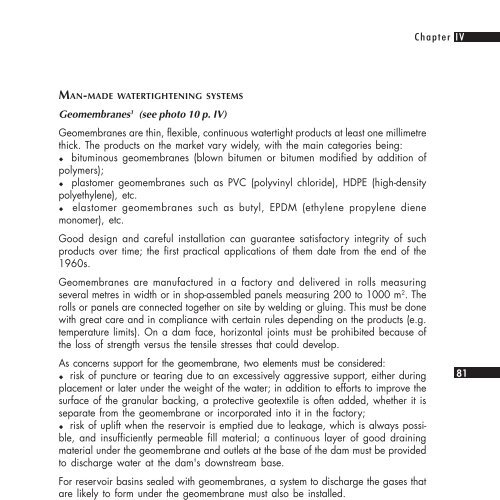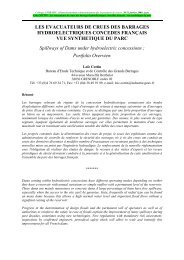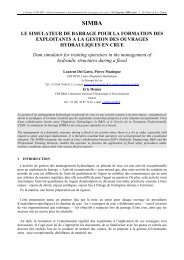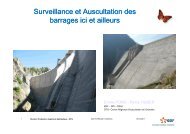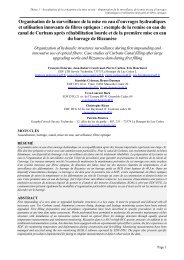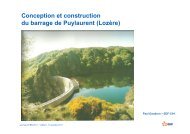SMALL DAMS
SMALL DAMS - Comité Français des Barrages et Réservoirs
SMALL DAMS - Comité Français des Barrages et Réservoirs
- No tags were found...
You also want an ePaper? Increase the reach of your titles
YUMPU automatically turns print PDFs into web optimized ePapers that Google loves.
Chapter IV<br />
MAN-MADE WATERTIGHTENING SYSTEMS<br />
Geomembranes 1 (see photo 10 p. IV)<br />
Geomembranes are thin, flexible, continuous watertight products at least one millimetre<br />
thick. The products on the market vary widely, with the main categories being:<br />
!" bituminous geomembranes (blown bitumen or bitumen modified by addition of<br />
polymers);<br />
!" plastomer geomembranes such as PVC (polyvinyl chloride), HDPE (high-density<br />
polyethylene), etc.<br />
! " elastomer geomembranes such as butyl, EPDM (ethylene propylene diene<br />
monomer), etc.<br />
Good design and careful installation can guarantee satisfactory integrity of such<br />
products over time; the first practical applications of them date from the end of the<br />
1960s.<br />
Geomembranes are manufactured in a factory and delivered in rolls measuring<br />
several metres in width or in shop-assembled panels measuring 200 to 1000 m 2 . The<br />
rolls or panels are connected together on site by welding or gluing. This must be done<br />
with great care and in compliance with certain rules depending on the products (e.g.<br />
temperature limits). On a dam face, horizontal joints must be prohibited because of<br />
the loss of strength versus the tensile stresses that could develop.<br />
As concerns support for the geomembrane, two elements must be considered:<br />
!" risk of puncture or tearing due to an excessively aggressive support, either during<br />
placement or later under the weight of the water; in addition to efforts to improve the<br />
surface of the granular backing, a protective geotextile is often added, whether it is<br />
separate from the geomembrane or incorporated into it in the factory;<br />
!" risk of uplift when the reservoir is emptied due to leakage, which is always possible,<br />
and insufficiently permeable fill material; a continuous layer of good draining<br />
material under the geomembrane and outlets at the base of the dam must be provided<br />
to discharge water at the dam's downstream base.<br />
For reservoir basins sealed with geomembranes, a system to discharge the gases that<br />
are likely to form under the geomembrane must also be installed.<br />
Surface protection from ultraviolet radiation and from traffic on a geomembrane,<br />
wave action, floating debris and vandalism can be provided by rip-rap or concrete<br />
slabs. A transition is required to protect the geomembrane, and geotextiles fulfil this<br />
function very well.<br />
It is important to verify stability against sliding at the various interfaces and avoid any<br />
tensile stress on the geomembrane.<br />
It is not unfeasible to provide no surface protection for geomembranes at small dams,<br />
but this implies at least minimum surveillance; repairs are easy to make, but<br />
geomembranes will be more vulnerable, they will age more rapidly, and any efforts<br />
to pull a person or an animal accidentally fallen into the reservoir out again can be<br />
very difficult.<br />
81<br />
1. See Bibliography, references 5 and 6, p. 111.


